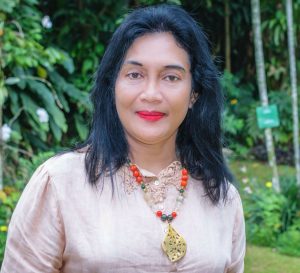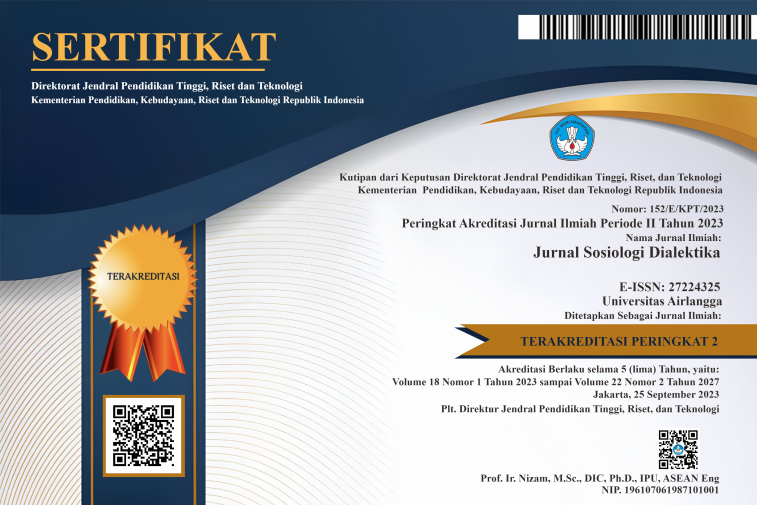Between the Tongkonan building and the Marampa' Church: The strategy of "adaptive space” for the Torajan migrant community in Jayapura City
Downloads
This paper examines the strategies of Torajan migrants that helped them to adapt to Jayapura City. This study was inspired by Edward Brunner and Suparlan to understand the concept of the dominant culture. This study uses qualitative research methods, collected by observations, interviews, documentation techniques, and through some of the literature on the migration of the Toraja people. The informants in this study is people who had come in the early days to Jayapura City. They were also members of the Toraja Family Association. These studies found out that the migrants tended to follow the dominant culture, dominated the dominant culture, and created the rules of the game for all communities to follow. They also have identity symbols, such as the Tongkonan building and the Marampa' Church in Jayapura City. Hypothetically, these symbols show that they are able to adapt to Jayapura City. This study found that the Torajan migrant community in Jayapura took advantage of a strategy called "adaptive space.” This strategy is carried out through cultural redefinition and by identifying similarities with the dominant culture. They also provide for the common needs in the dominant culture and constructing external relations to adapt in Jayapura City.
Abdurahim A (2015) Makna biaya dalam upacara Rambu Solo. Jurnal Akuntansi Multiparadigma 6 (2):175-184.
Abubar M (2019) 2600 pengungsi Wamena masih ditampung di Tongkonan Jayapura. [Accessed 20 January 2021] https://papua.antaranews.com/berita/508130/2600-pengungsi-wamena-masih-di-tampung-di-tongkonan-jayapura.
Adams KM (1984) Come to Tana Toraja, "land of the heavenly kings. Annals of Tourism Research, 11 (3):469-485.
Adams KM (2015) Families, funerals and Facebook: Reimag(in)Ing and 'curating' Toraja kin in trans-local times. TRaNS: Trans-Regional and -National Studies of Southeast Asia 3 (2):239-266.
Adams KM (2018a) Local strategies for economic survival in touristically volatile times: An Indonesian case study of microvendors, gendered cultural practices, and resilience. Tourism, Culture and Communication 18 (4):287-301.
Adams KM (2018b) Leisure in the "Land of the Walking Dead”: Western Mortuary Tourism, The Internet, and Zombie Pop Culture in Toraja, Indonesia. Denver: University of Colorado Press.
Adams KM (2020) What western tourism concepts obscure: intersections of migration and tourism in Indonesia. Tourism Geographies, 1-26. DOI: 10.1080/14616688.2020.1765010.
Alexander A (2019) Raputallang sebagai konsep konseling kontekstual di Masyarakat Toraja. BIA': Jurnal Teologi dan Pendidikan Kristen Kontekstual 2 (2):235-247.
Baharuddin A, Wibisono BH, Prayitno B & Roychansyah MS (2015) Heterogenity of Amber and Komin in shaping settlement pattern of Jayapura City. Komunitas: International Journal of Indonesian Society and Culture 7 (2):324-332.
Anderson B (1991) Imagined Communities: Refelctions on the origin and spread nationalism. London: Verso.
Boelaars J (1986) Manusia Irian Dahulu,Sekarang, Masa Depan. Gramedia, Jakarta.
Bruner EM (1974) The expression of ethnicity in Indonesia. In: Cohen A (ed). The International Behavioural and Social Sciences Library, Urban Ethnicity. Tavistock: Routledge. 251-280.
Creswell JW (2007) Research Design: Qualitative, Quantitative and Mixed Method Aproaches. New York: SAGE Publications.
Duli A & HU (2003) Toraja Dulu dan Kini. Makassar: Lembaga Penelitian dan Penerbitan Buku.
De Jong E (2013) Making a Living between Crises and Ceremonies in Tana Toraja: The Practice of Everyday Life of a South Sulawesi Highland Community in Indonesia. Leiden: Brill Academic Publishers.
Erna Mustafa A, Arman A, Sirajuddin SN & Saudi NS (2019) Social status relationship to purchase of tedong bonga for the Community Toraja Tribes. IOP Conference Series: Earth and Environmental Science, 247:1-6.
Gayatri E (2018) Christian Torajan youth in perceiving Aluk To Dolo. Al-Albab 7 (1):91-102.
Greenwood MJ (1997) Chapter 12 internal migration in developed countries. Handbook of Population and Family Economics 1 (part B):647-720.
Hafid A (2016) Hubungan sosial masyarakat multientik di Kabupaten Luwu Selawesi Selatan. Al-Qalam 22 (2):256-268.
Haryono TJS (2007) Jaringan sosial migran sirkuler: Analisis tentang bentuk dan fungsi. Masyarakat, Kebudayaan dan Politik 20 (2):75-86.
Hasbi, Sukimi MF, Latief MI & Yusriadi Y (2019) Compromise in traditional ceremonies: A case study of the Rambu solo' ceremony in Toraja regency. Humanities and Social Sciences Reviews 7 (6):286-291.
Hatta IT (2015). Insiden Trigana, keluarga harapkan jenazah teridentifikasi. Cendana News, 23 August.
[Accessed 16 January 2021].https://www.cendananews.com/2015/08/insiden-trigana-keluarga-harapkan-jenazah-teridentifikasi.html.
Hudriansyah H (2018) Konversi agama migran Toraja: Motivasi dan implikasinya terhadap hubungan etnik-religi Toraja di Kota Bontang, Kalimantan Timur. Lentera: Jurnal Ilmu Dakwah dan Komunikasi 2 (1):49-77.
Ismail R (2019) Ritual kematian dalam agama asli Toraja "Aluk To Dolo" (Studi atas upacara kematian Rambu Solok). Religi Jurnal Studi Agama-agama 15 (1):87-106.
Kausar DRK & Gunawan MP (2018) Managing heritage tourism in Toraja: SStrengthening local values and improving tourists' experiences. Journal of Heritage Tourism 13 (6):1-12.
Latuputty S (2013) Gereja Kristen Injili di tanah Papua dan pengembangan spiritualitas Oikumene di Indonesia Timur. Dinamis 2 (12):5-9.
Lawene CL, Tondobala L & Mononimbar W (2017) Pengembangan kawasan permukiman di Kota Jayapura. SPASIAL 4 (1):79–90.
Lee ES (1966) A theory of Migration. Demography 3 (1):47-57.
McGibbon R (2004) Plural society in peril: Migration, economic change, and the Papua conflict. Washington DC: East-West Center.
Nuruddin S (2016) Pola pembinaan mualaf di Kota Jayapura. Al-Qalam 18 (2):188-197.
Nyompa S, Alit N, Fuad Mat Jali M & Rostam K (2012) Migration and its impacts on social and economic aspects in Makassar City, South Sulawesi, Indonesia. Jurnal Perspektif: Jurnal Sains Sosial dan Kemanusiaan 4 (2):67-83.
Pakan MSL, Pratiknjo MH & Mamosey WE (2018) Rumah adat "Tongkonan” orang Toraja Kabupaten Tana Toraja Propinsi Sulawesi Selatan. HOLISTIK, Journal of Social and Culture 11 (22):1-16.
Patandean M, Baka WK & Hermina S (2018) Tradisi To Mo'Badong dalam upacara Rambu Solo' pada Suku Toraja. LISANI: Jurnal Kelisanan, Sastra, dan Budaya 1 (2):134-139.
Rima G (2019) Persepsi mayarakat Toraja pada upacara adat Rambu Solo' dan implikasinya terhadap kekerabatan masyarakat di Kecamatan Makale Kabupaten Tana Toraja. Phinisi Integration Review 2 (2):227-237.
Romdiati H & Surtiari GAK (2020) Orang Asli Papua: Kondisi Sosial Demografi dan Perubahannya. Jakarta: Yayasan Pustaka Obor Indonesia.
Rumbi FP (2018) Tradisi Massuru' dan pertobatan dalam Injil Sinoptik. BIA': Jurnal Teologi dan Pendidikan Kristen Kontekstual 1 (1):26-38.
Sampe N (2020) Rekonstruksi paradigma ekonomis dalam budaya Rambu Solo' di Toraja Utara. BIA': Jurnal Teologi dan Pendidikan Kristen Kontekstual 3 (1):26-43.
Sandarupa S (2014) Kebudayaan Toraja moral bangsa, milik dunia. Sosiohumaniora 16 (1):1-9.
Sudarsi ET, Taula'bi' N & Girik Allo MD (2019) Filosofi Tallu Lolona dalam Himne Passomba Tedong (etnografi kearifan lokal Toraja). SAWERIGADING 25 (2):61-73.
Suparlan P (2014) Kemajemukan, hipotesis kebudayaan dominan dan kesukubangsaan. Antropologi Indonesia 30 (3):229-236.
Supriyono J (2014) Diskursus kolonialistik dalam pembangunan di Papua: Orang Papua dalam pandangan negara. Jurnal Ultima Humaniora 2 (1):59-78.
Suryawan IN (2014) Stop kam baku tipu: Pemekaran daerah, isu strategis pengelolaan konflik, dan transformasi sosial di Papua Barat. Masyarakat Indonesia 40 (2):229-243.
Tande J (2005) Perubahan budaya Rambu Solo' orang Toraja di lingkungan Gereja Kristen Injili "Pniel” Kotaraja di Jayapura: Suatu kajian sosiologi budaya masyarakat Toraja di Kotaraja Jayapura. Thesis, Universitas Hasanuddin, Makassar.
Tirtosudarmo R (1997) Economic development, migration, and ethnic conflict in Indonesia: A Preliminary observation. Journal of Social Issues in Southeast Asia 12 (2):293-328.
Tjiptoherijanto P (1995) Partisipasi masyarakat dalam menarik migrasi penduduk ke luar Jawa. Ekonomi dan Keuangan Indonesia 43 (4):371-392.
Tobar M (2020) Hubungan antar strata sosial dalam masyarakat modern (Kasus Rampanan Kapa' dalam masyarakat Tana Toraja). Hasanuddin Journal of Sociology 2 (1):17-34.
Todaro M (1989) Urbanization and rural-urban migration: Theory and policy. In: Economic Development in the Third World. New York: Longman.
Upton S (2009) The impact of migration on the people of Papua, Indonesia. A historical demographic analysis. A historical demographic analysis. Thesis, Department of History and Philosophy University of New South Wales, Sydney.
Volkman TA (1984) Great performances: Toraja cultural identity in the 1970s. American Ethnologist 11 (1):152-169.
Waterson R (2000) House, Place, and Memory in Tana Toraja (Indonesia). In: Cunningham C. (Author) & Joyce R & Gillespie S (Ed). Beyond kinship: Social and material reproduction in house societies. Philadelphia: University of Pennsylvania Press. 177-188.
Watopa YP (2018) Pola dan faktor penyebab perkembangan permukiman terhadap kawasan lindung Apo Kali Kelurahan Bhayangkara Distrik Jayapura Utara. Jurnal Bumi Indonesia 7(1).
Wafirotin KZ (2013) Dampak migrasi terhadap kondisi sosial ekonomi keluarga TKI di Kecamatan Babadan Kabupaten Ponorogo. Jurnal Ekuilibrium 11 (2):15-33.
Wekke IS (2017) Migrasi Bugis dan Madura di Selatan Papua Barat: Perjumpaan etnis dan agama di minoritas Muslim. Jurnal Intelektualita: Keislaman, Sosial dan Sains 6 (2):163-180.
Yamashita S (1979) "Politics of meat” death feast in the Sa'dan Toraja. The Japanese Journal of Ethnology 44:1-33.
Yamashita S (1982) Uma Minanga: An anthropological note of Sa'dan Toraja rice cultivation (Indonesia). Southeast Asian Studies (Kyoto) 20 (3):373-392.
Yamashita S (1986) The Toraja community in Ujung Pandang: A study on a local city in Indonesia. Southeast Asian Studies (Kyoto) 23 (4):419-438.
Yamashita S (1994) Manipulating ethnic tradition: The funeral ceremony, tourism, and television among the Toraja of Sulawesi. Indonesia 58:69-82.
1. Copyright of this journal is possession of Editorial Board and Journal Manager, by the knowledge of author, whilst the moral right of the publication belongs to the author.
2. Legal formal aspect of journal publication accessibility refers to Creative Commons Attribution-NonCommercial-ShareAlike (CC BY-NC-SA), implies that publication can be used for non-commercial purposes in its original form (cannot be modified).
3. Every publications (printed/electronic) are open access for educational purposes, research, and library. Other that the aims mentioned above, editorial board is not responsible for copyright violation.















